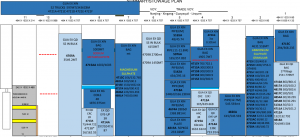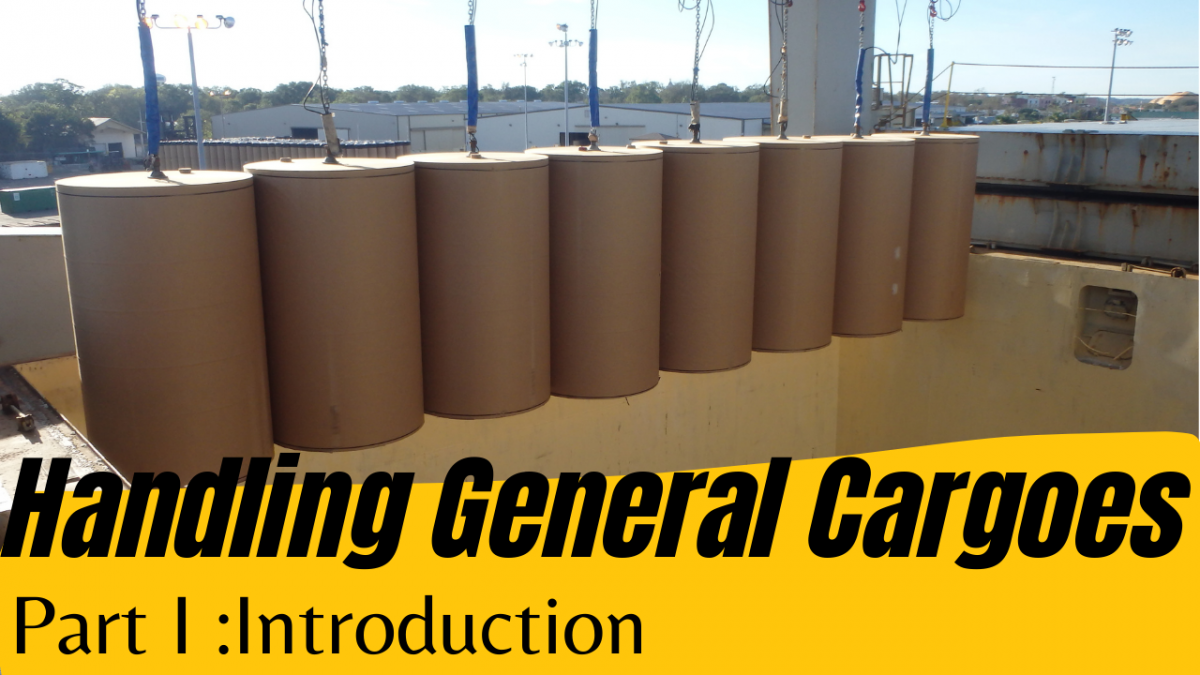- Your gateway to the Maritime Knowledge!
- [email protected]
General cargo series | Part I | Introduction

Every Sailors Cry
November 16, 2021
General Cargo series | Part II | Voyage instructions
February 8, 2022This series focuses on General cargo vessels and the specialized cargo which they carry. The general cargo vessels are built very differently compared to conventional bulk carriers. These differences may include but not be limited to – increased SWL of cranes, load bearing capacities of main deck and hatch covers, differently shaped holds, presence of tween decks. Additionally, depending upon the type of general cargo being carried – presence of sophisticated equipment such as – mechanical ventilation, temperature and dew point monitoring system, cargo hold smoke detection system and dehumidifier system.
On our Youtube Channel we have kickstarted the learning about General Cargo vessel. Through this series we shall be learning in depth concepts which are utilized in general cargo trade.
On thing you should always remember that General Cargo consists mainly of finished products. They are generally made for customer’s end use, are very expensive and requires of lot of care. So it is very important to learn about the core concepts of safe loading, carriage, care and discharge of such cargoes. Let me give you a few examples of cargoes which are commonly carried on general cargo ships.
- Steel products such as steel coils, steel pipes, plates bars and billets
- Bagged Cargoes such as chemicals, fertilizers etc
- Yachts and boats
- Defence equipment
- Windmill blades and wind towers
- Industrial equipment such as machinery
- Lumber and wood pulp
As you may note that most of these cargoes are finished products and therefore requires the deck officers to have a sound knowledge about cargo work.
As you have seen in the video lesson on our Youtube channel, how the general cargo ship looks like – including the construction of cargo holds, tween decks and hatch covers. The ship in discussion had gantry cranes used to facilitate cargo loading and discharging operations. You have to understand that the general cargo trade is quite different from the bulk cargo trade. The difference lies not only in the way the stowage plan is designed but also the cargo quantity is calculated. Another major difference is the way the cargo is secured – sometimes using specialized equipments such as air bags. The cargo documentation is also quite different. Let us now discuss the steps which you should keep in mind in case you plan to land upon a general cargo vessel.
- Know your vessel – as much as I highlight this point in my each blog, it is of utmost importance to know the vessel you are working upon. Most of the senior officers are not aware of the vessel’s they are sailing on – forget about the limitations of the vessel. This single fact may lead to many problems on a ship. However, knowing your ships in and out may lead to solving numerous problems. By knowing the vessel what I mean is that the crew should be aware of following -a. The general particulars of the ship
b. Construction of the vessel
c. Critical operations and limitations – such as ballasting, deballasting, stripping, cargo hold bilge operation, emergency hatch cover operation
d. Limitations and capacities of vessel’s cargo gear equipment
e. Stability booklet and Loading information including limitations on loading
f. Cargo securing manual and load densitiesThe above points are not limited and may include other sources of information such as manuals, plans etc. -
Read the Voyage instructions carefully – Voyage instructions shall be carefully read by all senior officers. Thoughtful discussion must be done in order to discuss all stages of the voyage with special focus on Bunker requirement, ECA entry-exit, draft limitations, loadline zone, hold cleaning and wash water discharge, requirement of any special equipment in order to expedite voyage etc. Additionally, you should be aware of the special requirements of the trade and the cargo being carried. All stages of the voyage shall be carefully evaluated and rough plan shall be chalked out
-
Understand the stowage plan – A ship’s primary purpose is to carry cargo. Different trades requires the vessel to carry different types of cargo. If you are well versed with the requirements of Point 1 which I mentioned above, you would be able to devise a good stowage plan for the ship – which will carry the optimum amount of the cargo without compromising on the safety of the vessel. Like I said that the general cargo trade is very different from the conventional bulk cargo trade, therefore the knowledge of cargo dimensions , hold dimensions and allowable load densities would only be beneficial in ensuring that optimum cargo is carried onboard the vessel.
In almost every case the stowage plan for general cargo is usually devised by a shore-based expert (known as Port Captain) who prepares the plan in accordance with the cargo hold dimensions. This stowage is then sent to vessel and vessel is asked whether the plan seems acceptable. The ship’s Chief Officer then feeds the stowage plan into the loadicator and checks whether the drafts, stress, trim, stability etc are acceptable at all stages of voyage. A general cargo stowage plan typically looks like below –

You might be finding it pretty confusing. However, it is not that complicated. With the right approach you can break the stowage plan into simple terms for better understanding.
Always remember, that the basic concepts of loading applies to general cargo as much as they apply to loading of any other type of cargo. The common sense and good seamanship should always prevail.
-
The loadicator – Ask any 2nd mate (aspiring to be a Chief Mate) and all he says that he wants to practice on loadicator. In my belief, there is nothing to practice on loadicator. Simply speaking, loadicator is just like a handheld calculator. Do you practice working on a calculator? No.
A calculator is the digital application of basic operation such as addition, subtraction, multiplication and division that we all learn as kids. Similarly, loadicator is the digital application of the vessel’s stability manual which gives results in single click rather than manual calculation.
So, ensure that you are familiar with the basic operation of the onboard loadicator but what is more important is that you should be WELL VERSED with loading and stability manuals. To familiarize yourself with the loadicator, i highly recommend to read it’s instruction manual.
Moving on, the pre-stow plan obtained in step 3 is now fed into the loadicator and results for various stages of the voyage is obtained. Most of the times, the pre-stow plan is amended in relation to stress, stability, max cargo quantity and achieved drafts basis limitations. Always remember, the basics of deadweight calculation and stowage plan always remain same no matter what ship you are on. We have discussed the basics of stowage plan and deadweight calculation on our Youtube channel.
- Hold cleaning requirements – Most of the general cargoes carried are finished products transported for end-use. Hence, the hold cleaning requirements are usually pretty stringent. Imagine a cargo of paper pulp, which requires absolutely shining holds. On the other hand, carriage of cargo such as steel coils may require a normally cleaned hold. Many a time, general cargo may also carry bulk cargoes such as chemicals, grain or specialized concentrates. The cleaning standards may vary for different cargoes. You should seek charters guidance regarding hold cleaning requirements for the cargo intended to be carried. This shall be asked in sufficient time so that required equipment and paints can be sourced in time.
To read about various hold cleaning standards, click here. -
Cargo Securing Manual (CSS) – One of the most important procedure involving safe carriage of general cargo is the manner in which the cargo is secured. The vessel’s Cargo Securing Manual details the vital ship specific information with reference to securing devices, allowable load densities, securing arrangements to be adopted for standardized and non-standardized cargoes. To gain a better perspective about effective securing arrangements for the varied cargo types the knowledge of vessel’s cargo securing manual is must. Always remember that lashing arrangements used in lashing the cargo shall never be lesser than those proposed by the cargo securing manual. If the cargo securing utilizes specialized equipment such as welding of d-rings, fitting of air bags etc same shall be confirmed through charters in advance.
-
Ventilation requirements – Many of the general cargoes are susceptible to damage esp due to the fact that they are loaded at colder temperature and voyage progresses through higher temperatures. If the ventilation is not controlled during this period, the cargo the chances of cargo getting damaged due to formation of sweat are quite high. Ventilation requirements for individual cargoes shall always be confirmed by shippers in advance. Few cargoes might not require ventilation at all while some cargoes may require controlled ventilation or thorough ventilation. Incorrect ventilation results in damaged cargo frequently resulting in heavy cargo claims.
-
Gather information from Shippers – General cargoes are of varying nature, some are finished goods and some are unprocessed. Whatever may be the case, the Shippers of the cargo are the best judge in determining the state in which the cargo is being transported and the care required during its transit. One should never shy away from collecting as much as information from the shipper about carriage guidelines. Most of the shippers have been transporting such goods since many years and they can give you the best advice regarding vessel’s queries. Shipper’s can be contacted through the Agent.
So next time you land upon a general cargo vessel, the above points will give you a kick start as to how to approach ahead. In our next blog, we shall discuss above points in detail.
Stay tuned.
********************************************************************************************************************
Follow us on –
Youtube: https://www.youtube.com/channel/UC711…
Facebook: https://www.facebook.com/funnel2tunne…
Linkedin: https://www.linkedin.com/company/funn…
Twitter: https://twitter.com/funnel2tunnel
Instagram: https://www.instagram.com/funnel2tunn…



